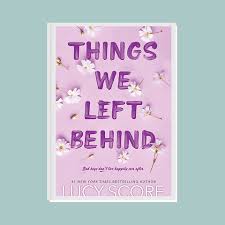Things We Left Behind: A Journey Through Time and Change
In the ever-evolving landscape of human history, certain elements inevitably fade into the past as new innovations and trends emerge. Things We Left Behind is a powerful concept that encompasses everything from obsolete technologies to outdated customs. This article explores various aspects of what we’ve left behind, how these elements shaped our present, and what their remnants can teach us about our future.
The Evolution of Technology: From Typewriters to Smartphones
The Age of Typewriters
Once a staple in offices around the world, the typewriter was a marvel of early technology. Invented in the 19th century, it revolutionized the way documents were produced, making typing faster and more efficient compared to hand-writing. However, with the advent of personal computers and word processing software, typewriters have largely become relics of the past.
The Rise of Computers
The transition from typewriters to computers marked a significant shift in technology. Early computers were bulky and expensive, but they laid the groundwork for the digital revolution. As technology advanced, personal computers became more affordable and powerful, leading to the development of laptops, tablets, and ultimately, smartphones.
The Smartphone Era
Smartphones have replaced many of the functions previously served by typewriters and early computers. With capabilities ranging from word processing to instant communication, smartphones have become indispensable in modern life. The once-common typewriter has largely been left behind, illustrating how rapidly technology evolves and how quickly new innovations can supplant older ones.
Cultural Shifts: Traditional Customs and Practices
The Decline of Traditional Communication Methods
In the past, communication was largely dictated by face-to-face interactions, handwritten letters, and landline telephones. These methods, while personal, have been largely overshadowed by email, text messaging, and social media. This shift has changed how we interact with others, making communication faster but sometimes less personal.
The End of Certain Social Norms
Many traditional social norms and practices have also faded. For example, formal etiquette and elaborate social rituals that were once common are now seen as outdated by some. This reflects a broader trend toward more casual and informal interactions in both personal and professional contexts.
The Impact on Relationships
The transformation in communication methods has had a profound impact on relationships. While digital communication allows for instant connection, it has also introduced challenges such as the decline in face-to-face interactions and the potential for miscommunication.
Fashion and Lifestyle: Trends We’ve Outgrown
The Evolution of Fashion
Fashion is another area where we see a constant stream of changes. Trends that were once considered cutting-edge are often replaced by new styles. For instance, bell-bottom jeans and neon colors, popular in the 70s and 80s respectively, are rarely seen in contemporary fashion.
Lifestyle Changes
Lifestyle trends also reflect what we’ve left behind. The shift from a more physically demanding lifestyle to one dominated by sedentary activities is a prime example. Previously, daily life involved more manual labor and physical exertion, whereas modern life often involves long hours of sitting and technology use.
The Nostalgia Factor
Despite the rapid changes, there is a strong sense of nostalgia associated with past fashion and lifestyle trends. Vintage clothing and retro-inspired designs often make a comeback, highlighting how elements of the past continue to influence present-day trends.
Education and Learning: Outdated Methods vs. Modern Approaches
Traditional Education Methods
Historically, education was conducted through rote memorization and passive learning methods. Textbooks and lectures were the primary tools used, and classroom settings were rigid and uniform. These methods have shaped generations of learners but have become less effective in the modern context.
The Digital Revolution in Education
Today, the education landscape is vastly different. Online courses, interactive learning platforms, and digital resources have transformed how we learn. This shift has made education more accessible and adaptable to individual needs but has also posed challenges such as ensuring digital literacy and maintaining engagement.
The Future of Learning
Looking forward, the integration of artificial intelligence and virtual reality into education promises to further revolutionize learning. As these technologies develop, they may offer new ways to learn and interact, making past educational methods seem even more outdated.
Environmental Changes: From Industrialization to Sustainability
The Industrial Revolution
The Industrial Revolution marked a dramatic shift in human society, driving technological and economic growth but also leading to significant environmental changes. The focus on industrialization and mass production had far-reaching effects on the environment, contributing to pollution and resource depletion.
The Rise of Environmental Awareness
In response to the environmental challenges posed by industrialization, there has been a growing emphasis on sustainability. Modern practices now prioritize eco-friendly technologies, renewable energy sources, and waste reduction. This shift reflects a growing awareness of the need to balance progress with environmental stewardship.
The Legacy of Industrialization
Although industrialization has left a lasting impact on society and the environment, its legacy is a driving force behind contemporary efforts to create a more sustainable future. The lessons learned from past practices inform current strategies for environmental conservation and innovation.
The Role of Memory and Nostalgia
Remembering What We’ve Left Behind
As we move forward, it’s natural to reflect on the things we’ve left behind. Memory and nostalgia play significant roles in how we view the past and how we integrate it into our present lives. Whether it’s a fond recollection of a vintage object or a longing for simpler times, these elements contribute to our collective cultural identity.
The Influence on Contemporary Culture
Nostalgia often influences contemporary culture, leading to the revival of past trends and the re-evaluation of what we’ve left behind. This cyclical nature of cultural trends demonstrates how the past continues to shape the present and future.
Preserving the Past
Efforts to preserve historical artifacts, traditional practices, and cultural heritage reflect a desire to maintain a connection to what we’ve left behind. Museums, historical societies, and digital archives play crucial roles in keeping the past alive and accessible for future generations.
Conclusion: Embracing Change While Honoring the Past
“Things We Left Behind” serves as a reminder of the dynamic nature of human progress. As we continue to advance and innovate, it’s important to acknowledge and appreciate the elements of the past that have shaped our present. By understanding what we’ve left behind, we gain valuable insights into our history, culture, and future.
Embracing change while honoring the past allows us to navigate the complexities of modern life with a sense of continuity and perspective. As we move forward, let us remember that the things we’ve left behind are not merely relics but integral parts of our shared journey through time.





Leave a Reply